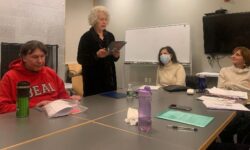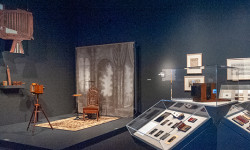[ccfic caption-text format="plaintext"]
By Laura Drinan
Hometown Weekly Reporter
As students headed back to school at the beginning of the month, the community was been eager to discover what intriguing pieces of art and culture Wellesley College’s Davis Museum would house. On September 19, the Davis Museum opened to the public, unveiling impressive and diverse collections from a variety of artists, including Eddie Martinez’s installation, “Ants at a Picknic,” which takes a nontraditional look at mandalas.
One exhibit called “Martin Luther: Protest in Print,” curated by Meredith Fluke, includes a collection of prints and books from the Wellesley College Special Collections and items borrowed from the Yale University Art Gallery. This year marks the five hundredth anniversary of Martin Luther’s “Disputation on the Power of Indulgences,” which contributes to visitors’ interest in the array of prints on display. The collection includes early printed books, some portraits of Luther and other prominent figures in the Reformation, drawings of visions of the apocalypse, and the secular response.

Framed engravings from Reformation artists are included in the Davis Museum’s “Martin Luther: Protest in Print” exhibition.
As visitors walked into the Hrair Sarkissian exhibition, they stepped into a completely dark room with a screen on the wall and one on the floor that continuously played Sarkissian’s “Horizon.” The 2016 video was shot by a drone flying above the Mycale Strait to show one of the most common refugee routes from Turkey to Greece. “It’s an unusual installation. It’s two video installations in conjunction. It tracks the refugee passage across the water,” explained Lisa Fischman, the exhibition’s curator. “It’s very moving, it’s very quiet, and it’s terrifying.”
Moving to another part of the globe, curator Amanda Gilvin spoke about the Soong Mayling exhibit. Mayling was a 1917 Wellesley College graduate, so the collection is in honor of the centenary of her graduation. Mayling became the First Lady of the Republic of China and was very well educated. Among her many talents was painting, which she took up in 1951. The five paintings that Mayling gifted to Wellesley College make up the collection.
Amanda Gilvin also addressed printmaking in South Africa in the exhibition she curated, “Life on Paper: Contemporary Prints in South Africa.” The exhibition includes drypoints, lithographs, screenprints, woodcuts, and other prints from South African artists. The prints are all quite recent, too, with the oldest one being from 1999.

Artist, Eddie Martinez, and curator, Lisa Fischman, in front of one of Martinez’s large-scale, nontraditional mandalas.
“Printmaking has a really unique place in the art history of South Africa,” began Gilvin. Printmaking was taught to white students, while racist policies forbid people of color to attend formal fine arts schools. However, informal craft-training institutes taught linocuts to artists who were not allowed in formal schools. “As the anti-apartheid movement became stronger and stronger from the 50s into the 80s, printmaking became a very important medium for political artists to disseminate their message through both image and print.”
The range of art and culture amazed visitors as they explored the world through the Davis’ collections.
Ranging from a refugee route filmed by a drone and themes of the Protestant Reformation to South African prints and art from the First Lady of the Republic of China, the Davis Museum takes visitors on a trip around the globe while simultaneously celebrating different styles and forms of art.






















